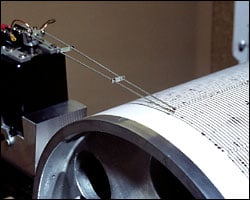
Earthquakes
Experiments
 |
| This seismometer is the tool that scientists use
to record earthquakes and determine their size. Try making your own! |
Make a Quake Detector
Materials:
- Newspaper
- Shoe Box
- Scissors
- Can of Soup
- Tape
- Felt-tip Marker that has a clip and a cap
- 18" of string
- Paper
Directions:
- Cover your desk with newspaper.
- Put the shoebox on your desk, then cut a 1" slit in the middle
of the lid, about 1" from the end of it.
- Place the open box upright. Put the can of soup inside the box to
hold it down.
- Positioning the slit away from the box, place the lid on top to form
an upside-down "L" Tape the lid to the box.
- Take the cap off the marker and put it on the other end of the marker.
- Tie the string to the clip and the cap.
- Thread the other end of the string through the slit in the box lid.
Adjust the string length so the pen just hits the paper.
- Tape the string to the box lid to stop it from sliding loose.
- Place a sheet of paper under the pen. Slowly pull the paper.
Describe the line that your seismometer created. What will the graph
made from a seismometer look like when the earth is trembling?
Seismometers — also known as geophones and seismographs — measure
motion. Why would scientists want to measure how strong an earthquake
is? (Answers will vary. So they can help make buildings, roads, bridges,
etc., strong enough to survive earthquakes of varying strengths.)
|


